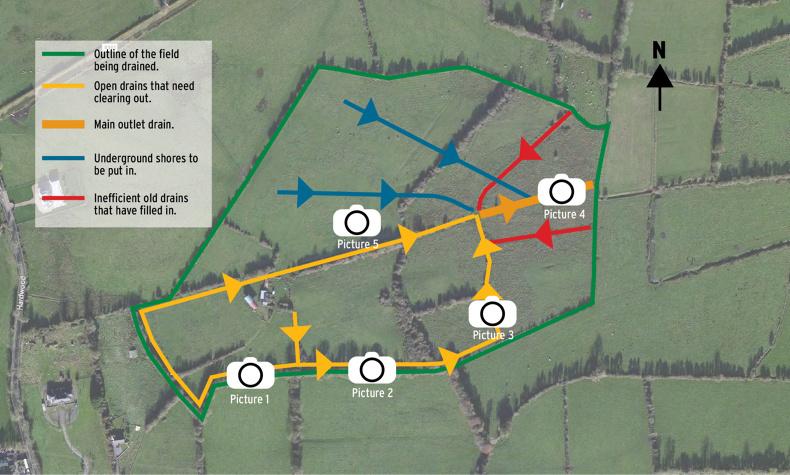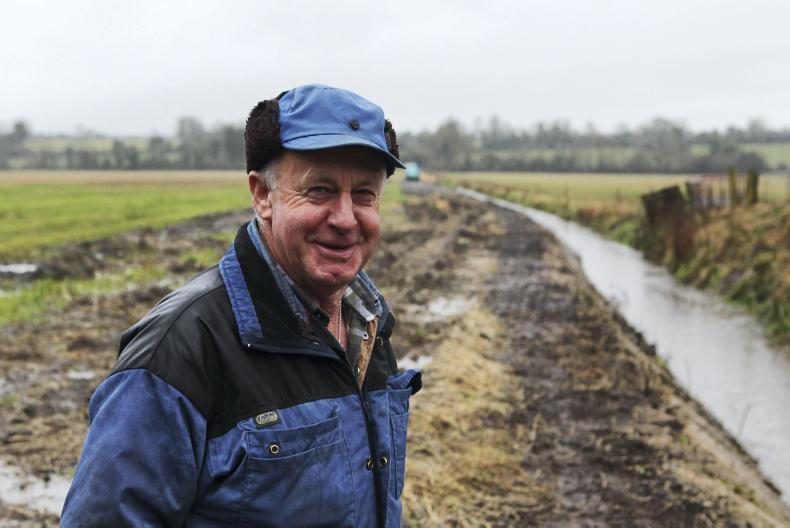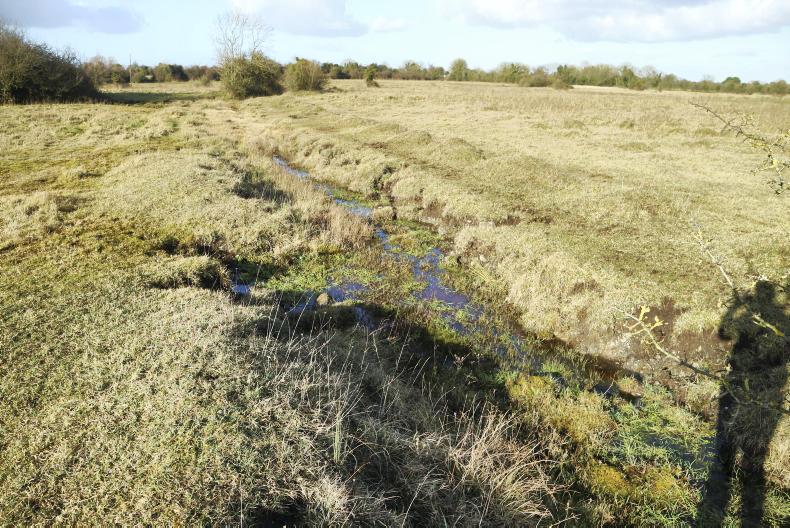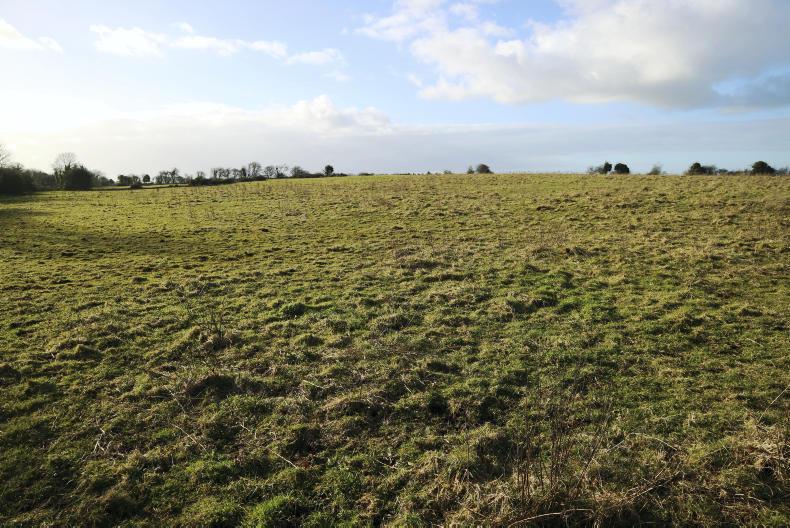I recently visited a 40ac Westmeath farm which the farmer has only newly purchased and has big plans to develop into an efficient grazing platform.
The land has been neglected for many years, but ambitious plans are afoot to bring the parcel back to a productive state. The farm is laid out in one block, with the land type divided into three main sections. About a third of the land to the right-hand side of the map is very wet and marshy and currently holding a lot of stagnant water.

The area towards the top of the map is mainly a hill. However, there is a wet area at the top of the hill that holds water. For this reason, underground drainage will be needed for this section of the field. To the left-hand side of the map is a relatively dry section of land. However, it still holds a large amount of surface water during periods of heavy rain.
Transform

Dessie Taaffe, Eagle Plant HireA considerable amount of work will be required to transform this land into good grazing land, with Dessie Taaffe of Eagle Plant Hire (pictured) the contractor tasked with carrying out the initial drainage work for the parcel.
“The first job is to get the water off the land,” according to Dessie. With a large network of over 1,200m of open drains requiring major attention, this is not as simple as it sounds.
“When it comes to land, people will always say that a farmer knows his land better than anyone else. This might be true for the first 12in of soil but under this they don’t know exactly what’s happening,” according to Dessie.

Picture two
Picture two.
The existing drains need to be opened up and cleaned out, with no movement of water in the drains at present meaning there is a lot of water sitting on the land. The land also requires the installation of approximately 400m of underground shores.
The water will drain away to the right-hand side (east) due to the natural fall of the land. The yellow lines indicate open drains that need cleaning out. The majority of these drains are completely ineffective, with roots and debris having blocked them up.
Top end
Dessie prefers to work from the top end of a drain first as this way when the drain is opened at the end and the water can move along the drain it will carry and help to wash out the scrub and extra debris that has gathered in the drain. Dessie admits that the majority of contractors would work from the bottom of the drain. However, this method works for him. The scrub and overgrown trees will be cleared out, as seen in pictures one and two which show after and before pictures of the same length of drain. The drain itself will then be cleared out.

Picture threePicture three.
Once cleaned out, the drains marked with a thin yellow line will be approximately 4ft deep. These will all feed into a larger drain that will act as the main outlet for collected water from the lands.
Adjoining this larger outlet drain are two smaller drains, marked in red. These smaller drains were installed in the past as the main outlet drain was not working efficiently. Over time, these drains have filled in completely and the plan is to leave them this way.
Outlet
Dessie says that these extra outlet drains serve no purpose if the main outlet drain (Picture 4) is properly cleaned out. This drain is currently about 1ft deep and carries very little water off the land. Once completed, the large outlet drain will be 5ft wide at the bottom and 12ft wide at the top, with a depth of approximately 6ft.

Pictuer fourPicture four.
The two underground shores that are being installed across the hill will begin at 3ft deep moving to 4ft as they get closer to the main outlet drain. A 110mm pipe will be placed in these shores, with 20in of 3in stone covering the pipes. This will then be covered by topsoil. As the land is so wet, Dessie first plans to open up a channel to carry the majority of the water down to the outlet. Then the pipes and shores will be installed.
This project will be revisited over the coming months to examine the progress made draining the land and any other reclamation work required. The initial plan is believed to cost approximately €12,000, with the majority of this being spent on excavator work. Once completed, a more accurate breakdown of the costs involved will be provided because at this point it is difficult to know if further underground shores will be required.

Picture fivePicture five
Read more
Full coverage: drainage
I recently visited a 40ac Westmeath farm which the farmer has only newly purchased and has big plans to develop into an efficient grazing platform.
The land has been neglected for many years, but ambitious plans are afoot to bring the parcel back to a productive state. The farm is laid out in one block, with the land type divided into three main sections. About a third of the land to the right-hand side of the map is very wet and marshy and currently holding a lot of stagnant water.

The area towards the top of the map is mainly a hill. However, there is a wet area at the top of the hill that holds water. For this reason, underground drainage will be needed for this section of the field. To the left-hand side of the map is a relatively dry section of land. However, it still holds a large amount of surface water during periods of heavy rain.
Transform

Dessie Taaffe, Eagle Plant HireA considerable amount of work will be required to transform this land into good grazing land, with Dessie Taaffe of Eagle Plant Hire (pictured) the contractor tasked with carrying out the initial drainage work for the parcel.
“The first job is to get the water off the land,” according to Dessie. With a large network of over 1,200m of open drains requiring major attention, this is not as simple as it sounds.
“When it comes to land, people will always say that a farmer knows his land better than anyone else. This might be true for the first 12in of soil but under this they don’t know exactly what’s happening,” according to Dessie.

Picture twoPicture two.
The existing drains need to be opened up and cleaned out, with no movement of water in the drains at present meaning there is a lot of water sitting on the land. The land also requires the installation of approximately 400m of underground shores.
The water will drain away to the right-hand side (east) due to the natural fall of the land. The yellow lines indicate open drains that need cleaning out. The majority of these drains are completely ineffective, with roots and debris having blocked them up.
Top end
Dessie prefers to work from the top end of a drain first as this way when the drain is opened at the end and the water can move along the drain it will carry and help to wash out the scrub and extra debris that has gathered in the drain. Dessie admits that the majority of contractors would work from the bottom of the drain. However, this method works for him. The scrub and overgrown trees will be cleared out, as seen in pictures one and two which show after and before pictures of the same length of drain. The drain itself will then be cleared out.

Picture threePicture three.
Once cleaned out, the drains marked with a thin yellow line will be approximately 4ft deep. These will all feed into a larger drain that will act as the main outlet for collected water from the lands.
Adjoining this larger outlet drain are two smaller drains, marked in red. These smaller drains were installed in the past as the main outlet drain was not working efficiently. Over time, these drains have filled in completely and the plan is to leave them this way.
Outlet
Dessie says that these extra outlet drains serve no purpose if the main outlet drain (Picture 4) is properly cleaned out. This drain is currently about 1ft deep and carries very little water off the land. Once completed, the large outlet drain will be 5ft wide at the bottom and 12ft wide at the top, with a depth of approximately 6ft.

Pictuer fourPicture four.
The two underground shores that are being installed across the hill will begin at 3ft deep moving to 4ft as they get closer to the main outlet drain. A 110mm pipe will be placed in these shores, with 20in of 3in stone covering the pipes. This will then be covered by topsoil. As the land is so wet, Dessie first plans to open up a channel to carry the majority of the water down to the outlet. Then the pipes and shores will be installed.
This project will be revisited over the coming months to examine the progress made draining the land and any other reclamation work required. The initial plan is believed to cost approximately €12,000, with the majority of this being spent on excavator work. Once completed, a more accurate breakdown of the costs involved will be provided because at this point it is difficult to know if further underground shores will be required.

Picture fivePicture five
Read more
Full coverage: drainage












 This is a subscriber-only article
This is a subscriber-only article










SHARING OPTIONS: